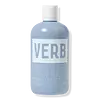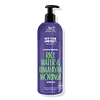What's inside
What's inside
 Key Ingredients
Key Ingredients

No key ingredients
 Benefits
Benefits

 Concerns
Concerns

 Ingredients Side-by-side
Ingredients Side-by-side

Water
Skin ConditioningGlycerin
HumectantCocamidopropyl Betaine
CleansingDisodium Laureth Sulfosuccinate
CleansingSodium Lauroyl Sarcosinate
CleansingSodium C14-16 Olefin Sulfonate
CleansingLaureth-3
EmulsifyingPEG-120 Methyl Glucose Trioleate
CleansingPanthenol
Skin ConditioningCocamide Mea
EmulsifyingGlycol Distearate
EmollientChondrus Crispus Extract
Skin ConditioningAscophyllum Nodosum Extract
Skin ConditioningLaminaria Saccharina Extract
Skin ProtectingPalmaria Palmata Extract
Skin ProtectingUndaria Pinnatifida Extract
Skin ConditioningTrichilia Emetica Seed Butter
EmollientAspergillus Ferment
Skin ConditioningArginine
MaskingXylitylglucoside
HumectantAnhydroxylitol
HumectantXylitol
HumectantSodium Methyl 2-Sulfolaurate
CleansingSodium Lauryl Sulfoacetate
CleansingPropanediol
SolventParfum
MaskingPolyquaternium-7
Dimethicone Pg-Diethylmonium Chloride
Polyquaternium-10
Gluconolactone
Skin ConditioningButylene Glycol
HumectantSodium Chloride
MaskingSilicone Quaternium-20
Skin ConditioningSodium Sulfate
Lauric Acid
CleansingXanthan Gum
EmulsifyingAmodimethicone
Hydroxypropyl Guar Hydroxypropyltrimonium Chloride
Bis-PCA Dimethicone
Cetrimonium Chloride
AntimicrobialQuaternium-80
Sarcosine
Skin ConditioningTrideceth-12
EmulsifyingLinoleamidopropyl Pg-Dimonium Chloride Phosphate Dimethicone
Disodium 2-Sulfolaurate
CleansingHydroxypropylammonium Gluconate
HumectantHydroxypropylgluconamide
HumectantHexylene Glycol
EmulsifyingDisodium PEG-12 Dimethicone Sulfosuccinate
CleansingPropylene Glycol
HumectantIsopropyl Alcohol
SolventMaleic Acid
BufferingCitric Acid
BufferingAminomethyl Propanol
BufferingSodium Acetate
BufferingPotassium Sorbate
PreservativeSodium Benzoate
MaskingCalcium Gluconate
HumectantBenzyl Alcohol
PerfumingTartaric Acid
BufferingDehydroacetic Acid
PreservativeLimonene
PerfumingHexyl Cinnamal
PerfumingHydroxycitronellal
PerfumingLinalool
PerfumingWater, Glycerin, Cocamidopropyl Betaine, Disodium Laureth Sulfosuccinate, Sodium Lauroyl Sarcosinate, Sodium C14-16 Olefin Sulfonate, Laureth-3, PEG-120 Methyl Glucose Trioleate, Panthenol, Cocamide Mea, Glycol Distearate, Chondrus Crispus Extract, Ascophyllum Nodosum Extract, Laminaria Saccharina Extract, Palmaria Palmata Extract, Undaria Pinnatifida Extract, Trichilia Emetica Seed Butter, Aspergillus Ferment, Arginine, Xylitylglucoside, Anhydroxylitol, Xylitol, Sodium Methyl 2-Sulfolaurate, Sodium Lauryl Sulfoacetate, Propanediol, Parfum, Polyquaternium-7, Dimethicone Pg-Diethylmonium Chloride, Polyquaternium-10, Gluconolactone, Butylene Glycol, Sodium Chloride, Silicone Quaternium-20, Sodium Sulfate, Lauric Acid, Xanthan Gum, Amodimethicone, Hydroxypropyl Guar Hydroxypropyltrimonium Chloride, Bis-PCA Dimethicone, Cetrimonium Chloride, Quaternium-80, Sarcosine, Trideceth-12, Linoleamidopropyl Pg-Dimonium Chloride Phosphate Dimethicone, Disodium 2-Sulfolaurate, Hydroxypropylammonium Gluconate, Hydroxypropylgluconamide, Hexylene Glycol, Disodium PEG-12 Dimethicone Sulfosuccinate, Propylene Glycol, Isopropyl Alcohol, Maleic Acid, Citric Acid, Aminomethyl Propanol, Sodium Acetate, Potassium Sorbate, Sodium Benzoate, Calcium Gluconate, Benzyl Alcohol, Tartaric Acid, Dehydroacetic Acid, Limonene, Hexyl Cinnamal, Hydroxycitronellal, Linalool
Water
Skin ConditioningSodium Lauroyl Sarcosinate
CleansingSodium Cocoyl Isethionate
CleansingCocamidopropyl Hydroxysultaine
CleansingPEG-120 Methyl Glucose Dioleate
EmulsifyingGlycol Distearate
EmollientPropanediol
SolventCocodimonium Hydroxypropyl Hydrolyzed Rice Protein
Skin ConditioningOryza Sativa Extract
AbsorbentMoringa Oleifera Seed Extract
Skin ConditioningPolyquaternium-10
Tetrasodium Glutamate Diacetate
Phenoxyethanol
PreservativeEthylhexylglycerin
Skin ConditioningParfum
MaskingCitric Acid
BufferingCaramel
Cosmetic ColorantWater, Sodium Lauroyl Sarcosinate, Sodium Cocoyl Isethionate, Cocamidopropyl Hydroxysultaine, PEG-120 Methyl Glucose Dioleate, Glycol Distearate, Propanediol, Cocodimonium Hydroxypropyl Hydrolyzed Rice Protein, Oryza Sativa Extract, Moringa Oleifera Seed Extract, Polyquaternium-10, Tetrasodium Glutamate Diacetate, Phenoxyethanol, Ethylhexylglycerin, Parfum, Citric Acid, Caramel
Ingredients Explained
These ingredients are found in both products.
Ingredients higher up in an ingredient list are typically present in a larger amount.
Citric Acid is an alpha hydroxy acid (AHA) naturally found in citrus fruits like oranges, lemons, and limes.
Like other AHAs, citric acid can exfoliate skin by breaking down the bonds that hold dead skin cells together. This helps reveal smoother and brighter skin underneath.
However, this exfoliating effect only happens at high concentrations (20%) which can be hard to find in cosmetic products.
Due to this, citric acid is usually included in small amounts as a pH adjuster. This helps keep products slightly more acidic and compatible with skin's natural pH.
In skincare formulas, citric acid can:
While it can provide some skin benefits, research shows lactic acid and glycolic acid are generally more effective and less irritating exfoliants.
Most citric acid used in skincare today is made by fermenting sugars (usually from molasses). This synthetic version is identical to the natural citrus form but easier to stabilize and use in formulations.
Read more about some other popular AHA's here:
Learn more about Citric AcidGlycol Distearate serves as a pearlizing or opacifying agent in cosmetic products.
It's often included in cleansers and haircare products to give them a lustrous or shimmering appearance.
It is derived from stearic acid, a natural fatty acid commonly found in vegetable oils and animal fats.
Glycol Distearate isn't fungal acne safe.
Learn more about Glycol DistearateParfum is a catch-all term for an ingredient or more that is used to give a scent to products.
Also called "fragrance", this ingredient can be a blend of hundreds of chemicals or plant oils. This means every product with "fragrance" or "parfum" in the ingredients list is a different mixture.
For instance, Habanolide is a proprietary trade name for a specific aroma chemical. When used as a fragrance ingredient in cosmetics, most aroma chemicals fall under the broad labeling category of “FRAGRANCE” or “PARFUM” according to EU and US regulations.
The term 'parfum' or 'fragrance' is not regulated in many countries. In many cases, it is up to the brand to define this term.
For instance, many brands choose to label themselves as "fragrance-free" because they are not using synthetic fragrances. However, their products may still contain ingredients such as essential oils that are considered a fragrance by INCI standards.
One example is Calendula flower extract. Calendula is an essential oil that still imparts a scent or 'fragrance'.
Depending on the blend, the ingredients in the mixture can cause allergies and sensitivities on the skin. Some ingredients that are known EU allergens include linalool and citronellol.
Parfum can also be used to mask or cover an unpleasant scent.
The bottom line is: not all fragrances/parfum/ingredients are created equally. If you are worried about fragrances, we recommend taking a closer look at an ingredient. And of course, we always recommend speaking with a professional.
Learn more about ParfumPolyquaternium-10 is an ammonium salt of hydroxyethylcellulose. It is a white and granular powder used as a film-former and anti-static agent.
This ingredient is commonly found in hair conditioning products. According to a manufacturer, its positive charge makes it great for absorbing hair proteins. The manufacturer also states this ingredient helps with curl retention.
For haircare friends: this ingredient is not a silicone.
Learn more about Polyquaternium-10Propanediol is an all-star ingredient. It softens, hydrates, and smooths the skin.
It’s often used to:
Propanediol is not likely to cause sensitivity and considered safe to use. It is derived from corn or petroleum with a clear color and no scent.
Learn more about PropanediolSodium Lauroyl Sarcosinate is a cleansing agent and emulsifier. It is a surfactant derived from sarcosine, and a common source is coconut oil.
As a surfactant, Sodium Lauroyl Sarcosinate helps lift dirts, oil, and other molecules to be washed away. In leave-on products, this ingredient is used as an emulsifier. Emulsifier help prevent ingredients such as oils and waters from separating.
Sodium Lauroyl Sarcosinate is also commonly found as a foaming agent in shampoo, toothpaste, and shaving foam. It is amphiphilic, meaning it loves both water and fats.
Learn more about Sodium Lauroyl SarcosinateWater. It's the most common cosmetic ingredient of all. You'll usually see it at the top of ingredient lists, meaning that it makes up the largest part of the product.
So why is it so popular? Water most often acts as a solvent - this means that it helps dissolve other ingredients into the formulation.
You'll also recognize water as that liquid we all need to stay alive. If you see this, drink a glass of water. Stay hydrated!
Learn more about Water